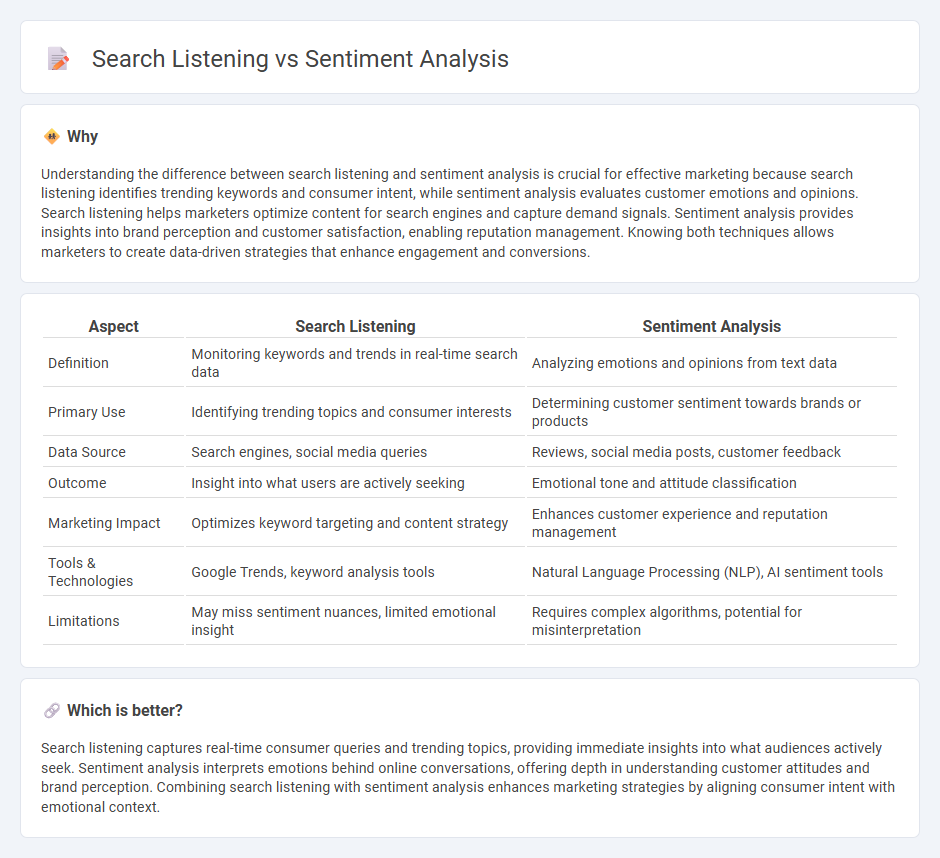
Search listening captures real-time consumer queries and trending topics by monitoring search engine data, offering insights into audience interests and demand patterns. Sentiment analysis processes textual data from social media, reviews, and forums to gauge consumer emotions and opinions about brands or products. Explore how leveraging both techniques can enhance your marketing strategy with deeper customer understanding.
Why it is important
Understanding the difference between search listening and sentiment analysis is crucial for effective marketing because search listening identifies trending keywords and consumer intent, while sentiment analysis evaluates customer emotions and opinions. Search listening helps marketers optimize content for search engines and capture demand signals. Sentiment analysis provides insights into brand perception and customer satisfaction, enabling reputation management. Knowing both techniques allows marketers to create data-driven strategies that enhance engagement and conversions.
Comparison Table
| Aspect | Search Listening | Sentiment Analysis |
|---|---|---|
| Definition | Monitoring keywords and trends in real-time search data | Analyzing emotions and opinions from text data |
| Primary Use | Identifying trending topics and consumer interests | Determining customer sentiment towards brands or products |
| Data Source | Search engines, social media queries | Reviews, social media posts, customer feedback |
| Outcome | Insight into what users are actively seeking | Emotional tone and attitude classification |
| Marketing Impact | Optimizes keyword targeting and content strategy | Enhances customer experience and reputation management |
| Tools & Technologies | Google Trends, keyword analysis tools | Natural Language Processing (NLP), AI sentiment tools |
| Limitations | May miss sentiment nuances, limited emotional insight | Requires complex algorithms, potential for misinterpretation |
Which is better?
Search listening captures real-time consumer queries and trending topics, providing immediate insights into what audiences actively seek. Sentiment analysis interprets emotions behind online conversations, offering depth in understanding customer attitudes and brand perception. Combining search listening with sentiment analysis enhances marketing strategies by aligning consumer intent with emotional context.
Connection
Search listening captures real-time consumer queries, providing valuable data on user intent and preferences. Sentiment analysis processes this data by evaluating emotions and opinions expressed in search behaviors, enabling marketers to gauge public perception accurately. Together, these techniques refine marketing strategies by aligning content and campaigns with audience sentiment trends and demand patterns.
Key Terms
Opinion Mining
Sentiment analysis and search listening both play crucial roles in opinion mining, with sentiment analysis focusing on evaluating emotional tone in textual data and search listening emphasizing real-time monitoring of consumer queries and conversations. By combining sentiment analysis algorithms with search listening technologies, businesses can gain comprehensive insights into public opinion and brand perception across multiple platforms. Explore deeper to understand how integrating these tools enhances strategic decision-making in marketing and customer engagement.
Keyword Tracking
Sentiment analysis evaluates customer emotions in social media and reviews, while search listening tracks keyword performance across search engines to optimize SEO strategies. Keyword tracking provides real-time insights into search trends, helping businesses adjust content for higher visibility and engagement. Explore in-depth keyword tracking techniques to enhance your digital marketing success.
Brand Perception
Sentiment analysis quantifies consumer emotions about a brand by evaluating text data from social media, reviews, and surveys to gauge positive, neutral, or negative opinions. Search listening captures real-time trends and consumer intent by analyzing keyword queries and search behavior, reflecting how audiences actively seek brand-related information. Explore the nuances of brand perception through advanced sentiment analysis and search listening techniques to enhance marketing strategies.
Source and External Links
What is Sentiment Analysis? | Definition from TechTarget - Sentiment analysis, also known as opinion mining, is an approach in natural language processing that identifies the emotional tone (positive, negative, or neutral) behind a body of text, helping organizations gauge public opinion about products, services, or ideas.
Sentiment Analysis and How to Leverage It - Sentiment analysis interprets qualitative data to understand how people feel about a topic, converting subjective opinions in reviews, social posts, or surveys into quantifiable positive, negative, or neutral metrics for actionable business insights.
What Is Sentiment Analysis? - Sentiment analysis is the process of analyzing large volumes of text--such as emails, tweets, and reviews--to determine whether the expressed sentiment is positive, negative, or neutral, enabling companies to better understand customer experiences and improve brand reputation.
 dowidth.com
dowidth.com